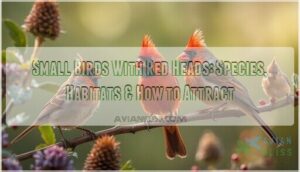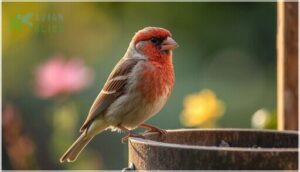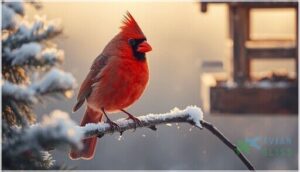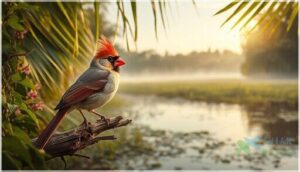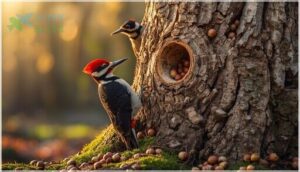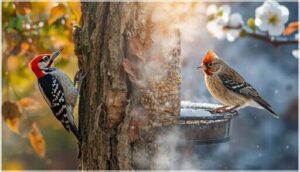This site is supported by our readers. We may earn a commission, at no cost to you, if you purchase through links.
You spot a flash of crimson at your feeder, and suddenly you’re hooked—nothing grabs attention quite like a small bird sporting a red head. These colorful characters aren’t just eye candy; they’re some of North America’s most fascinating backyard visitors, each with distinct personalities and quirks.
The red crown you’re seeing could belong to a House Finch belting out his morning song, a Northern Cardinal surveying his territory, or even a rare warbler passing through on migration. What makes identification tricky is that “red-headed” doesn’t mean the same thing across species—some flash full crimson caps, others wear subtle rosy washes, and a few sport dramatic crests that look almost punk rock.
Once you learn to read the patterns, behaviors, and habitats that distinguish these ruby-crowned visitors, you’ll transform casual birdwatching into a rewarding skill that opens up your backyard like never before.
Table Of Contents
- Key Takeaways
- What Defines a Red-Headed Small Bird?
- Common Species of Small Birds With Red Heads
- Less Common and Regional Red-Headed Birds
- Habitat and Behaviors of Red-Headed Birds
- Attracting and Supporting Red-Headed Birds
- Frequently Asked Questions (FAQs)
- What bird has a redhead?
- Does a bird have a red head?
- What does a red-headed bird look like?
- How many types of birds have red heads?
- What does a red-headed bird mean?
- What does a redpoll bird look like?
- What are the little birds with red heads?
- What bird looks like a sparrow but has a red head?
- Is a red-headed finch rare?
- How rare is a House Finch?
- Conclusion
Key Takeaways
- Red-headed small birds vary wildly in appearance—from House Finches with rosy crowns to Northern Cardinals sporting full crimson helmets with black masks—and identifying them requires reading distinct patterns in head coloration, beak shape, and body size that shift dramatically between species.
- Male red plumage intensity comes directly from dietary carotenoids converted during feather growth, meaning the brightness you see at your feeder reflects what that bird’s been eating, not just its genetics.
- These birds split into three migration strategies—year-round residents like Cardinals, partial migrants such as House Finches that shift south seasonally, and nomadic wanderers like Red Crossbills that track food sources unpredictably across entire regions.
- Creating habitat with 70% native plants, proper feeders matched to species preferences, and window collision prevention transforms casual backyard birding into genuine conservation that supports declining populations while bringing these crimson-crowned visitors back year after year.
What Defines a Red-Headed Small Bird?
You’ve probably spotted a flash of red in your backyard and wondered what makes these little birds so distinctive. Red-headed small birds share a few telltale traits that go beyond just their colorful crowns—from body size to feather patterns, these features help you identify what you’re seeing.
Let’s break down the key characteristics that define these vibrant visitors.
Key Physical Characteristics
You’ll spot red-headed birds by their standout head patterns—think crimson caps, masked faces, or flaming crests. Males usually show the boldest red plumage, from House Finches’ rosy crowns to Northern Cardinals’ full-red helmets with striking black masks. Beak shapes vary too: Cardinals flash thick coral bills, while finches sport smaller conical ones.
Feather textures and plumage colors shift between species, making bird species identification an adventure once you know what defines each beauty. Understanding bird conservation efforts is vital for maintaining healthy habitats.
Typical Size and Measurements
Beyond the bold reds, you’ll notice these red-headed birds pack a lot of variation into compact frames. Small bird species usually measure 12 to 16 cm in body length—think House Finches at around 12.5 to 15 cm versus Northern Cardinals stretching 21 to 24 cm. Wing span runs 20 to 31 cm, while beak size and feather depth shift with diet.
These bird measurements matter for bird species identification in the field. The House Finch species is a key example of finch family traits that can help with identification.
Unique Plumage Patterns
Red plumage isn’t one-size-fits-all—you’ll see males sporting deep crimson crowns while females keep it subtle with browns and grays. That contrast helps with finch identification guide work and spotting mating displays. The red pigmentation comes from dietary carotenoids converted by special enzymes, creating feather structure that varies by species:
- Carotenoid-based red plumage coloration appears in 41% of passerines
- Males concentrate red headed birds markings on crown and throat
- Habitat darkness amplifies plumage variations for better bird camouflage
Common Species of Small Birds With Red Heads
You’ll spot quite a few small birds with red heads across North America, each with its own personality and charm. Some are backyard regulars you’ve probably seen at your feeders, while others prefer more secluded spots in forests or open woodlands.
Let’s look at four species you’re most likely to encounter on your birdwatching adventures.
House Finch (Haemorhous Mexicanus)
You’ll recognize a House Finch by the male’s rosy-red head, throat, and breast—a color that comes directly from carotenoids in the bird’s diet. These small finches, measuring about 12.5–15 cm with brown-streaked females, have spread from western roots to occupy backyards nationwide.
Their tendency to flock at feeders and adapt to suburban life makes House Finch identification straightforward for anyone watching birds with red heads.
Northern Cardinal (Cardinalis Cardinalis)
Watching a male Northern Cardinal feels like seeing fire among the branches—that vivid red plumage and black mask make this bird species unmissable. Cardinals stretch about 21–23 cm, larger than most finches, and their clear whistled song rings through backyards year-round.
Northern migration patterns have pushed these birds with red heads farther north thanks to feeders and warming winters, transforming cardinal diet and nesting habits across expanding ranges.
Red-Crested Cardinal (Paroaria Coronata)
If you’ve glimpsed a striking red-crested cardinal, you’ve discovered a true South American gem. This bird species—native to subtropical Brazil, Paraguay, and northern Argentina—sports vivid red plumage atop its head, gray back, and crisp white belly. Red crest habitat now extends to Hawaii and Puerto Rico thanks to bird migration via introductions. You’ll see these birds with red heads foraging on the ground in pairs, munching grass seeds and mulberries. Conservation status remains stable, though habitat quality matters for cardinal diet and long-term wildlife conservation.
- Body length runs 17–19 cm, smaller than Northern Cardinals
- Distinctive red head and crest contrast sharply with gray-and-white body
- Introduced populations thrive near rivers, marshes, and degraded forest edges
- Average lifespan hovers around 3.8 years in the wild
Acorn Woodpecker (Melanerpes Formicivorus)
You’ll spot this medium-small woodpecker social group defending a granary with fierce dedication—each bird species maintains thousands of acorns in drilled tree excavation sites.
Measuring 21 cm with a striking red head, Acorn Woodpeckers thrive in western oak woodlands where red head genetics and cooperative behavior drive acorn storage strategies.
Granary defense runs strong; related birds with red heads share territories, ensuring wildlife conservation through communal vigilance at every wooden fortress.
Less Common and Regional Red-Headed Birds
Beyond the usual backyard suspects, you’ll find some truly striking red-headed birds that don’t show up at every feeder. These species often stick to specific regions or habitats, making each sighting feel like a small victory.
Let’s look at four standout birds that might take a bit more patience—or adventure—to track down.
Pine Grosbeak (Pinicola Enucleator)
When boreal seed crops fail, Pine Grosbeaks trade their remote conifer forests for your winter feeder—a breathtaking example of irruptive behavior patterns tied to conifer seed dependence. These stout birds with red heads belong to boreal forest ecology, where their winter foraging strategies depend entirely on cone harvests. Partners in Flight estimates 11 million globally, yet you’ll rarely encounter them unless food scarcity drives Pine Grosbeak migration southward.
What makes Pine Grosbeaks remarkable in ornithology and the bird species world?
- Males glow rose-red against snowy pines—a color evolution designed for courtship visibility in dim northern forests
- Their tameness startles first-time observers—these red plumage birds evolved without significant predation pressure
- Nomadic wandering defines their existence—Pine Grosbeak migration corresponds to cone crops, not fixed routes
- Finnish studies show 27% occupancy decline—climate warming fragments their boreal forest ecology strongholds
- Irruptive years bring magic—suddenly, dozens appear where none existed, embodying true avian freedom
Cassin’s Finch (Haemorhous Cassinii)
Cassin’s Finch perches in high-elevation pines where few birders wander—3.2 million globally, yet Partners in Flight ranks them at concern score 13. Breeding habits are observed across 132,196 km² of Montana’s subalpine spruce-fir forests, where male red plumage glows crimson (brighter than House Finches).
Song variations echo through ponderosa woodlands during nesting patterns, while feather molting transforms juveniles.
Finch migration remains unpredictable—irruptive movements mirror seed crops, embodying mountain freedom.
Red-Faced Warbler (Cardellina Rubrifrons)
You’ll find Red-Faced Warblers flashing through Arizona’s high pines—350,000 strong yet declining. This avian species thrives at elevations where breeding habits unfold in pine-oak forests, nesting sites tucked in montane zones from May through September.
New Mexico’s Gila Forest hosts:
- 29 documented subpopulations mapped across vulnerable breeding grounds
- Song patterns ringing through mixed conifer-oak canopies
- Feather molting transforming juveniles before migration routes pull southward
- Bright red heads distinguishing them from other birds with red heads
- Redfaced Warbler territories spanning Central America’s mountains
Red Crossbill (Loxia Curvirostra)
Red Crossbills roam conifer forests across North America—20 million strong globally, yet the Canadian percna subspecies clings to just 1,000–2,500 individuals. You’ll recognize adult males by their deep red plumage and uniquely crossed beaks, perfectly adapted for prying seeds from pine cones.
Their irruptive migration patterns follow conifer seed crops, so abundant cone years keep them local while crop failures trigger wandering flocks that can show up anywhere.
Habitat and Behaviors of Red-Headed Birds
Red-headed birds aren’t all cut from the same cloth—they’ve each carved out their own niche in the wild. Some stick close to your backyard feeders year-round, while others follow the seasons or roam wherever food takes them.
Let’s break down where you’ll find these birds, how they behave, and what drives their movements throughout the year.
Preferred Environments and Ranges
You’ll spot these crimson-capped beauties across wildly different landscapes—from pine-draped mountain slopes to your neighborhood park. House Finches dominate urban and suburban zones coast to coast, thriving in built environments most species avoid.
Meanwhile, Red-faced Warblers stick to high-altitude pine–oak forests between 6,400 and 9,000 feet, and Red Crossbills wander nomadically through conifer-dominated boreal and montane zones, chasing cone crops wherever they ripen.
Social and Feeding Behaviors
Social hierarchies shape how these birds interact. House Finches gather in flocks of hundreds, with females often dominating males at bird feeders. Northern Cardinals form tight pair bonds and share winter roosts, while Acorn Woodpeckers practice cooperative breeding, with multiple adults provisioning nestlings together.
Foraging strategies vary wildly. Red Crossbills roam nomadically, tracking cone crops, whereas Pine Grosbeaks methodically strip buds in small flocks.
Seasonal Movements and Migration
Migration patterns split red-headed species into three groups: year-round residents like Northern Cardinals, partial migrants such as House Finches that shift south from northern ranges, and nomads including Red Crossbills that track food. Climate shift pushes many toward earlier spring arrivals—recent bird tracking shows fall migrants advancing dates as temperatures rise.
Key seasonal trends shaping avian migration patterns:
- Warming drives 6-day earlier green-up per degree Celsius
- Urban heat islands reduce migration propensity in House Finches
- Snow cover changes alter stopover habitat quality
- Food mismatches lower breeding success across species
- Higher-latitude populations face greatest habitat changes
For birdwatching enthusiasts, these shifts mean adjusting your calendar—birds with red heads now arrive weeks ahead of historical norms.
Attracting and Supporting Red-Headed Birds
You don’t need a wilderness refuge to bring these stunning red-headed birds to your own backyard. With the right plants, feeders, and a few thoughtful touches, you can create a space that feels like home to them.
Here’s what works best to attract and support these vibrant visitors year-round.
Native Plants and Garden Features
If you want to roll out the welcome mat for these scarlet-crowned visitors, native gardening is your secret weapon. Plant diversity matters—berry shrubs like elderberry and seed-bearing coneflowers deliver natural food year-round while garden structures like layered thickets offer shelter.
Studies show yards with 70% native plants support thriving bird populations. You’re not just birdwatching; you’re practicing habitat conservation and wildlife preservation that actually works.
Feeder Types and Food Preferences
Regarding bird feeders, matching design to your target species is half the battle. House Finches and other small red heads flock to tube feeders stocked with black oil sunflower or Nyjer seed, while cardinals prefer hopper or platform setups offering safflower and cracked corn.
Suet options boost winter bird nutrition—choose strategically, and you’ll master backyard birding tips that transform casual feeding into purposeful wildlife support.
Providing Water and Shelter
Beyond feeders, your water sources and shelter designs make or break red-headed bird habitat. Bird baths between 2–5 cm deep encourage safe bathing, while placement 3–6 meters from shrubs balances predator control with quick escape routes.
To round out backyard birding tips:
- Replace water daily to prevent mosquito larvae
- Install nesting boxes on metal poles with predator baffles
- Position baths in partial shade to slow algae
- Layer native shrubs for roosting cover
Conservation Tips for Backyard Birders
You can turn your backyard birding into real conservation efforts by tackling the biggest threats. Window collision prevention—decals spaced 5–10 cm apart—cuts strikes by over 50%.
Cat management strategies keep birds safer; outdoor cats kill up to 4 billion birds yearly in North America.
Keeping cats indoors protects birds—outdoor cats kill up to 4 billion birds yearly in North America
Bird-friendly gardens with native plant selection support habitat preservation, while avoiding pesticides protects the caterpillars red-headed species need.
Frequently Asked Questions (FAQs)
What bird has a redhead?
Several species flash red head coloration—House Finch and Red Crossbill males sport rosy crowns, while the Redheaded Woodpecker wears a complete crimson hood.
Head coloration intensity depends on carotenoid-rich diets during feather growth.
Does a bird have a red head?
Yes—many bird species sport red heads. Male House Finches, Northern Cardinals, and Red Crossbills all display striking head color variations.
Red plumage genetics and bird identification rely on these vibrant traits across finches, woodpeckers, and cardinals alike.
What does a red-headed bird look like?
Picture a flame perched on a branch—red heads catch your eye instantly, whether it’s the raspberry crown of a Cassin’s Finch or a cardinal’s crimson crest contrasting with black feathers.
How many types of birds have red heads?
Around 60 to 70 bird species worldwide sport red heads—spanning finches, cardinals, woodpeckers, and warblers. North America alone claims at least 13 small species, showcasing the trait’s global distribution and plumage genetics.
What does a red-headed bird mean?
Red plumage carries spiritual symbolism across cultures—some see redheaded woodpeckers as messengers or omens of courage, while others interpret red crossbills or finches as signs of vitality.
Cultural significance varies widely by tradition.
What does a redpoll bird look like?
You’ll spot redpolls by their signature crimson forehead patch, streaky brown-and-white body, and compact finch shape.
Males often flash a rosy breast wash, while their notched tails and conical beaks help crack seeds.
What are the little birds with red heads?
You’ll find House Finches and Northern Cardinals topping the list—males sport vivid red on their heads.
Redheaded Woodpeckers and Red-bellied Woodpeckers also catch your eye with striking head color variations.
What bird looks like a sparrow but has a red head?
You’ll recognize the House Finch most often—a brown-streaked sparrow lookalike crowned with fiery red. Males sport red-headed plumage on the breast and face, while females mimic plain sparrows, proving backyard attraction rewards patient bird identification.
Is a red-headed finch rare?
It depends on the species. The House Finch shows an 9% North American population increase over forty years, while Cassin’s Finch faces documented declines despite 2 million individuals, earning high conservation concern status.
How rare is a House Finch?
House Finch rarity? Think abundance instead. With populations climbing 9% over forty years and forty million birds breeding globally, these red-headed finches thrive coast-to-coast, dominating feeders in urban habitats despite occasional disease pressures.
Conclusion
Whether you’re identifying your first House Finch or tracking a rare warbler’s flyover, small birds with red heads become unmistakable once you know what to look for. The real reward isn’t just naming species—it’s watching their personalities unfold at your feeder, understanding their seasonal rhythms, and creating habitat they’ll return to year after year.
Set up the right plants and feeders, then let these crimson-crowned visitors transform your backyard into their stage.

